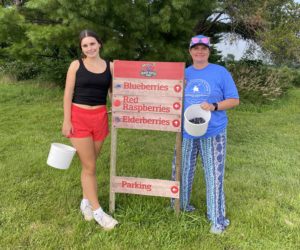Preserving the Magic of Our Soils
I’ve lived in Iowa most of my life. Upon graduating from college way back in 2001, I experienced the typical urge many do at that time of life to broaden my horizons by living anywhere except Iowa.

Due to Berry Patch Farm’s good stewardship of their rich soils, Sally and her daughter Maya were able to pick a bounty of blueberries at the Nevada, Iowa, farm this past summer.
When my husband and I lived outside of Iowa, we enjoyed experiencing the natural wonders of new places, from the lush New York Catskill Mountains to the vast expanse of federal land in Idaho. Yet, something felt amiss as I imagined living in these places long-term. I couldn’t pinpoint what the missing ingredient was.
We moved back to Iowa. Upon return, the feeling that something was missing went away. Iowa doesn’t have lush mountains or large swaths of federal land. So what was it about Iowa that filled my soul? Was it merely because it was familiar? In the 20 years since I’ve moved back, I slowly identified the missing ingredient – life-giving soil so rich it smells like home.
Soils Feed Us
Soil is fundamental to life on Earth. It filters our water, grows our food and captures carbon dioxide. Iowa soils are so rich that, precolonization, our ecosystems were some of the most biodiverse in the word. As you well know, Iowa’s soils have long provided us with abundance. From grains and pasture to vegetables and the rich, diverse prairie that once covered the land, Iowa’s soils are truly magical.
Since our state is blessed with fertile soil, we have harnessed most of its power to raise crops. Today, over 85% of Iowa’s land is devoted to agriculture. But the way we farm has become unbalanced. In the past, Iowa used to raise a wide diversity of crops. But as farming has become more efficient, the focus has narrowed to corn and soybeans – two annual crops that leave the land bare for about six months of the year. This contributes to nutrient loss and soil erosion.
As Iowa has shifted to fewer crops, the state has seen a dramatic drop in the number of farmers, from 206,000 in 1950 to 85,000 today. We’ve experienced rural community decline, loss of biodiversity, a decline in water quality and food insecurity. Iowans import more than 90% of our food, despite our fertile soils.
Our current monoculture farming system assumes that soil is an endless resource. However, as Iowa State University soil expert Lee Burras points out, if we keep farming the way we are, we have only about 60 years before our soils are essentially depleted.
40 Years of Sustaining Our Soils
Fortunately, PFI members have been attentive to the importance of sustaining our soils since 1985. Practical Farmers turned 40 earlier this year – and I am proud of the leadership our members have shown over this time.
You remain passionately committed to not only preserving but regenerating your soils. You share generously with others how you care for soil, as well as how you are adapting your production systems for better long-term soil health, like switching to no-till as the Pelzer family did (see page 22 of this magazine). This includes when you take vulnerable land out of production, like Natasha Wilson and her family did when they converted row crop ground to perennial pasture that supports a diverse array of plants and wildlife (see page 9).
PFI members are unwavering in their commitment to preserving Iowa’s soils, and they recognize the complexity of this task. They understand that soil regeneration goes beyond simply adding a new crop to their rotation. Rather, it demands a fundamental shift in the entire system. For a wider variety of crops to thrive, it takes dedicated research and development, viable markets, risk management, supply chain infrastructure and much more.
Forty years on, PFI members continue to lead by example and inspire hope. Thank you to Jeremy Gustafson and family for letting us celebrate this milestone at your field day in June, where you shared many details about how you are stewarding your soil.
The journey toward soil regeneration is challenging, but I can’t think of a more hopeful group of farmers and partners to join with than the dedicated people at PFI. Together, we’re building farming systems that support healthy soils, waters, communities, our health and the wildlife around us.
Thank you for your dedication to saving our magical soils. And here’s to another 40 years of building resilient farms and communities.
